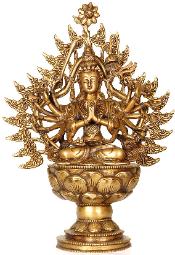Learning Point No 289
 |
| Lord Bo Tien |
The end of the first 13 years after the first descent of Lord Bo Tien in 1969 marks the end of trancing as the way for men to communicate with the lord saint. The anniversary or mission day messages served as the nuclei or seeds for growth of the God knowledge that we need to know behind all religions.
 |
| God and religions |
If men can see the oneness of religions and sects and why they need to be different as well, then there is more hope that religions and sects will serve their purposes and be complementary rather than be divisive.
Early members of any mission, like say of Lord Bo Tien must know that they are like candle flames to grow their light of God knowledge and to light up the light or candle flames in others. The candle flames must grow and come together to light up for society, the truth of God and his teachings common to and cutting all faiths.
But men being men may not see eye to eye and this is understandable. Any saint, notwithstanding Lord Bo Tien expects this and reminds all to be mindful of conflicts that may arise when men are still growing their light for their mission.
Let there be give and take. Let all agree to disagree and to live by differences if needed. This is not new but also the problem at macro-level - at the level of sects and religions as institutions.
If there be differences between men in mission or men in worship of a saint like the lord saint, let there be magnanimity and let them drop their squabbles and be amicable with one another.
Drop the case whatever it may be if men cannot agree. Do not fan up the differences but do more worthwhile and wholesome activities. Surely, there is much more to be done than splitting hairs and making mountains out of molehills.
By all means, do speak your mind and let others know what are your views even if they do not see eye to eye with you. But thereafter, move on and let go.
Mission to save souls cannot wait till there are no differences among men. Mission must carry on unabated and nothing must stay in its way, least of all differences and preferences of men in the mission.
Those who have not been correct will face fate and fate will still be kind to them in some way so long as they are mission orientated to save souls, their own as well as those of others. This is the way to ensure all religions and sects stay on course for mission to save souls and complement one another's good work.
Men must not be stubborn and obstinate like mules. They must not clash at any level and go for an eye for an eye and a tooth for a tooth. This will not be good for mission to save souls, be it at sect level or at the level of religion or between one man and another. This will be destructive and only end up destroying souls of those involved and will not help to save any soul.
The problem is that men do make mountain out of molehill. If that is the case, then they are like ants and insects thinking that their molehill is a mountain. Don't be blinded by the molehill but look ahead at the big picture, not at the molehill.
Then the mission to save souls will be on the right footing. Otherwise, there will be many problems with interpersonal conflicts, sectarian conflicts and religious conflicts within a religion, temple and across religions and temples.
"The problems and issues of men are many and plentiful." Lord Bo Tien said.
Learn from Ji Gong Posat. He is often portrayed reflecting on two crickets at odds with each other in a bowl. The problems between men are due to lack of yin yang harmony - balance between opposites, the soft and the hard aspects, be it of views or of life, be it religion or a mission.
Yin yang balance is the key to peace and success of any attempt to alleviate problems and to have peace and to achieve the ends be it spiritual or mundane. When there is lack of focus and no yin yang balance, we often make mountains out of molehills.























.jpg)










